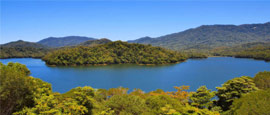Cairns History
From a rough-and-ready backwater that was home to only the hardiest pioneers, Cairns has evolved into a tropical, cosmopolitan success story.
Aboriginal peoples had lived in this region for thousands of years before British and other European settlers turned up.
The first European to discover the site of what is now called Cairns was Captain James Cook, who sailed up the coast of northeast Australia in June 1770. It was a difficult region to explore and Cook didn’t linger, sailing north after repairing his ship.
It was another 100 years before Europeans returned to the region. The discovery of gold to the west prompted an influx of miners and Cairns was established in 1876.
Its subsequent growth was largely thanks to its selection in 1892 as the starting point of a freight railway carrying goods to and from the Tableland. Construction of the track and its later expansion attracted huge numbers of immigrants.
In 1903, Cairns was officially declared a town, with a population of 3,500, before being listed as a city in 1923.
The development of agriculture, sugar cane and dairy industries led to its continued growth in the early 20th century.
During WWII, Australian and Allied troops were based in the city. When Singapore fell, over 7,000 people fled the region and headed south, many of them never to return.
Tourism started in earnest after WWII, helped along by the opening of the international airport in 1984 and the convention centre in 1996. Since then, Cairns has grown in leaps and bounds.
Did you know?
• Cairns was named after Sir William Wellington Cairns, the Queensland governor at the time of the city’s foundation.
• Cairns is the meeting point for two UNESCO World Heritage sites, the Great Barrier Reef and the Wet Tropics rainforest.
• The Olympic torch travelled on the SkyRail rainforest cable car and the Great Barrier Reef on its way to the Sydney Olympic Games in 2000.
Do you have any Feedback about this page?
© 2025 Columbus Travel Media Ltd. All rights reserved. No part of this site may be reproduced without our written permission, click here for information on Columbus Content Solutions.




 You know where
You know where